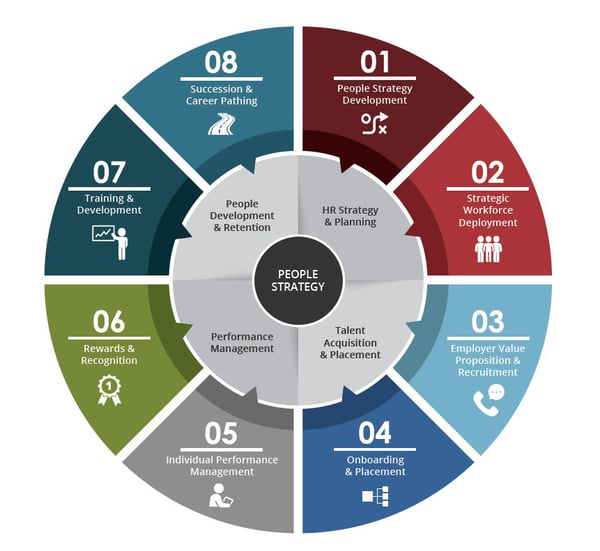by Judy Johnson, Ph.D.
August 16, 2019
When the job market is tight and employees have their pick of companies, we often find ourselves with a heightened need to better understand how we stack up in their eyes. That is currently the case in the marketplace, and we see this trend continuing into 2030. (For more on trends impacting the workplace of 2030, see our eBook, Organization Effectiveness for 2030 — Are You Ready? How the World of Work is Changing).
In the same way that you need to fight for market space, you need to also fight for your place in the talent market. By using Wargaming, you can better understand how you stack up against your biggest competition for top talent, and what you can do to improve your position.
 Talent Life Cycle
Talent Life Cycle
Using Wargaming to review your talent strategy and determine priorities across the talent life cycle will improve your perception among prospective, current, and past employees. All of these groups are important to maintain and build your community of talent.
1. Identify Your Competitors
Who do you compete with for top talent? It’s not just the same companies you compete with on products and services. For example, if you are looking for a business analyst, it doesn’t matter what industry you are in: your competition is every other company in your areas looking for a business analyst. Determine who are your biggest competitors for talent, as they will become the focus of your Wargaming.
2. Be the Competition
Take off your company hat and step into the role of your competitor’s CHRO. Understand who they are going after and why. What aspects of their recruiting, culture, environment, and career development make you so attractive? What are they going to do to try to win the war on talent? By understanding this, you can figure out how to beat it.
3. Look at Yourself from the Outside-In
Look at your organization. Not from your current role, but as that desirable recruit or the high performer you’d regret to lose. What do they see? How does it stack up against what the competition is doing? Why would you come work for the company? Or stay at it? Be honest. Be thorough. Don’t hold back. It’s better to understand all potential issues than gloss over a root cause of your challenges.
4. Plan to Win
Now that you are armed with your newly developed knowledge, set a talent strategy that differentiates you from the rest of your talent competition and positions you to win those highly desirable recruits, and retain the high performers once they are at your company.
5. Track, Fail, and Adjust to Truly Win
It’s best to have 100% structure and 100% flexibility. Obviously, having a clear, solid plan is a great start. However, then things change in the market or within your company and your plans need to be adjusted. You may also find that not everything you plan works out as intended. Track progress and be prepared to test some things out, quickly identify and stop things that are failing, identify and expand areas of progress, and create a culture for the HR team of continuous learning and development.
For more on Wargaming, read Marketing & Innovation Director Michele Petruccelli’s article Wargaming in Business to Get a Competitive Advantage. To see how your company is prepared for the trends for 2030 as well as benchmarking against a wide variety of other organizations and industries, take our Organizational Effectiveness assessment.